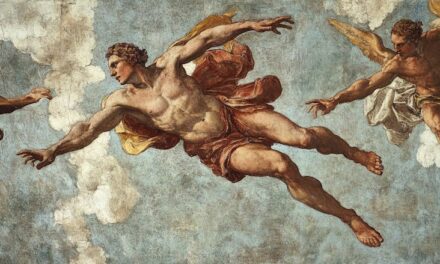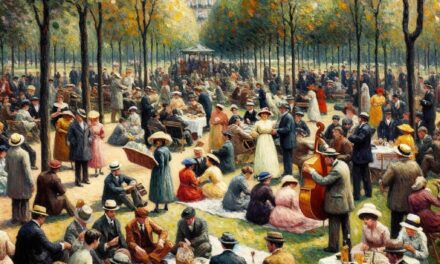Symbolism, as an artistic and literary movement, emerged in the late 19th century as a reaction against the naturalism and realism that dominated the arts at the time. It was a response to the Industrial Revolution and the rapid changes in society, seeking to explore the deeper, more spiritual aspects of human existence. The movement originated in France, with poets such as Charles Baudelaire and Stéphane Mallarmé, who sought to express their inner thoughts and emotions through symbolic imagery and metaphor.
Symbolism was also influenced by the works of Edgar Allan Poe and the Pre-Raphaelite Brotherhood in England, who embraced symbolism as a means of expressing their dissatisfaction with the materialistic and rationalistic values of their era. The Symbolist movement was not limited to literature and poetry; it also had a significant impact on visual arts, music and even philosophy. The movement was characterised by its rejection of direct representation and its embrace of suggestive and evocative imagery.
Symbolist artists sought to convey their innermost thoughts and emotions through symbols and allegories, often drawing inspiration from mythology, mysticism and the occult. This emphasis on the symbolic and the spiritual set Symbolism apart from the prevailing artistic trends of the time, marking it as a radical departure from the dominant modes of expression.
Summary
- Symbolism originated in the late 19th century as a reaction against naturalism and realism in art and literature.
- Key characteristics of Symbolism include an emphasis on the use of symbols and metaphors to convey emotions and ideas, as well as a focus on the subconscious and the spiritual.
- Symbolism in art is evident in the works of artists such as Gustav Klimt, Edvard Munch, and Odilon Redon, who used symbols to express inner emotions and spiritual truths.
- In literature, Symbolism is seen in the works of writers like Charles Baudelaire, Arthur Rimbaud, and W.B. Yeats, who used symbols to convey deeper meanings and emotions.
- Symbolism has had a significant impact on religion and spirituality, with symbols being used to represent abstract concepts and spiritual truths in various religious traditions.
- The impact of Symbolism on modern culture can be seen in the use of symbols in advertising, fashion, and popular culture, as well as in the continued exploration of the subconscious and spiritual themes in art and literature.
- In conclusion, Symbolism continues to be relevant today, as it provides a powerful means of expressing complex emotions and ideas that transcend language and culture.
Key characteristics of Symbolism
The Power of Symbolism
This emphasis on the symbolic allowed for a more subjective and personal expression, as artists and writers could convey their innermost thoughts and emotions without being bound by the constraints of realism or naturalism.
A Rejection of Materialism
Another key characteristic of Symbolism is its rejection of the materialistic and rationalistic values of the time. Symbolist artists and writers sought to explore the deeper, more spiritual aspects of human existence, often delving into themes of love, death, and the supernatural.
Exploring the Ineffable
This rejection of materialism and rationalism allowed for a more introspective and contemplative approach to art and literature, as Symbolists sought to convey the ineffable and the mysterious through their work.
Symbolism in art

In visual arts, Symbolism had a profound impact on artists such as Gustave Moreau, Odilon Redon, and Fernand Khnopff, who sought to convey their inner thoughts and emotions through suggestive imagery and allegorical narratives. These artists often drew inspiration from mythology, mysticism, and the occult, creating dreamlike and otherworldly compositions that sought to evoke a sense of mystery and wonder. Symbolist art often featured enigmatic figures, fantastical landscapes, and symbolic motifs, inviting viewers to contemplate the deeper meanings behind the imagery.
Symbolist art also had a significant influence on the development of modern art, particularly in its emphasis on subjective expression and its rejection of direct representation. The movement paved the way for later artistic movements such as Surrealism and Expressionism, which also sought to convey the inner workings of the mind through symbolic imagery and metaphor. The legacy of Symbolist art can be seen in the works of artists such as Salvador Dalí, Max Ernst, and Marc Chagall, who continued to explore the symbolic and the metaphorical in their own unique ways.
Symbolism in literature
In literature, Symbolism had a profound impact on writers such as Charles Baudelaire, Stéphane Mallarmé, and Arthur Rimbaud, who sought to convey their inner thoughts and emotions through suggestive imagery and allegorical narratives. These writers often drew inspiration from mythology, mysticism, and the occult, creating enigmatic and evocative works that sought to explore the deeper, more spiritual aspects of human existence. Symbolist literature often featured dreamlike narratives, rich symbolism, and lyrical language, inviting readers to contemplate the deeper meanings behind the text.
Symbolist literature also had a significant influence on the development of modern literature, particularly in its emphasis on subjective expression and its rejection of direct representation. The movement paved the way for later literary movements such as Surrealism and Magical Realism, which also sought to convey the inner workings of the mind through symbolic imagery and metaphor. The legacy of Symbolist literature can be seen in the works of writers such as Franz Kafka, Jorge Luis Borges, and Gabriel García Márquez, who continued to explore the symbolic and the metaphorical in their own unique ways.
Symbolism in religion and spirituality
Symbolism has long been associated with religion and spirituality, as it seeks to convey deeper meanings through symbolic imagery and metaphor. In many religious traditions, symbols are used to represent abstract concepts or spiritual truths that are difficult to express in words. For example, in Christianity, the cross is a powerful symbol of sacrifice and redemption, while in Hinduism, the lotus flower represents purity and enlightenment.
Symbolism allows for a more intuitive and contemplative approach to religious and spiritual matters, as it invites believers to meditate on the deeper meanings behind the symbols. In addition to its association with traditional religious symbols, Symbolism has also been linked to esoteric traditions such as alchemy, astrology, and Kabbalah. These mystical traditions use symbols to convey hidden truths about the nature of reality and the human experience.
Symbolism allows for a more intuitive and holistic understanding of these esoteric teachings, as it invites practitioners to contemplate the deeper meanings behind the symbols and their connections to the larger cosmic order.
The impact of Symbolism on modern culture

Influence on Artistic Movements
The emphasis on subjective expression and the rejection of direct representation that characterised Symbolism paved the way for later movements such as Surrealism, Expressionism, and Magical Realism, which also sought to convey the inner workings of the mind through symbolic imagery and metaphor. These movements have had a profound impact on modern art, literature, and philosophy, shaping our understanding of human consciousness and the nature of reality.
Influence on Popular Culture
Symbolism has also had a lasting impact on popular culture, particularly in its influence on film, music, and fashion. The dreamlike and otherworldly imagery that characterised Symbolist art has inspired filmmakers such as David Lynch and Guillermo del Toro, who have created surreal and fantastical worlds that invite viewers to contemplate deeper meanings behind the imagery.
Influence on Fashion and Music
In music, Symbolism has influenced artists such as Pink Floyd and Björk, who have used rich symbolism and metaphor in their lyrics to convey complex emotional and existential themes. In fashion, Symbolism has inspired designers such as Alexander McQueen and Jean Paul Gaultier, who have created enigmatic and evocative collections that seek to explore the deeper, more spiritual aspects of human existence.
The enduring relevance of Symbolism
In conclusion, Symbolism continues to be relevant in modern culture due to its emphasis on subjective expression, its rejection of direct representation, and its exploration of deeper spiritual truths through symbolic imagery and metaphor. The movement has had a profound impact on art, literature, religion, spirituality, and popular culture, shaping our understanding of human consciousness and the nature of reality. The enduring relevance of Symbolism can be seen in its influence on modern artistic movements such as Surrealism and Expressionism, as well as its impact on popular culture in film, music, and fashion.
As long as there is a need for deeper contemplation of human existence and spiritual truths, Symbolism will continue to be a powerful means of expression for artists, writers, thinkers, and creators across various disciplines.
If you are interested in learning more about the evolution of art movements, you may want to explore the post-impressionism movement. Post-impressionism was a reaction against the naturalism of impressionism and focused on the emotional and symbolic aspects of art. To delve deeper into this fascinating movement, check out the article on post-impressionism here.
FAQs
What is Symbolism?
Symbolism is an artistic and literary movement that emerged in the late 19th century, primarily in France, and spread throughout Europe. It sought to express emotions, ideas, and spiritual truths through symbols and allegories rather than through direct representation.
What are the key characteristics of Symbolism?
Key characteristics of Symbolism include a focus on the inner world of the individual, an emphasis on emotions and the subconscious, the use of symbols and metaphors to convey meaning, and a rejection of realism and naturalism in art and literature.
Who were some of the key figures in the Symbolist movement?
Some of the key figures in the Symbolist movement include poets such as Charles Baudelaire, Stéphane Mallarmé, and Arthur Rimbaud, as well as artists like Gustave Moreau and Odilon Redon. These individuals played a significant role in shaping the Symbolist aesthetic and philosophy.
How did Symbolism influence other art forms?
Symbolism had a significant influence on other art forms, including music, theatre, and the visual arts. Composers such as Claude Debussy and Maurice Ravel were influenced by Symbolist ideas, as were playwrights like Maurice Maeterlinck and visual artists such as Edvard Munch and Gustav Klimt.
What is the legacy of Symbolism in the arts?
The legacy of Symbolism in the arts is far-reaching, with its influence evident in subsequent movements such as Surrealism, Expressionism, and Art Nouveau. Symbolist ideas continue to resonate with artists and audiences, and the movement remains an important chapter in the history of art and literature.




